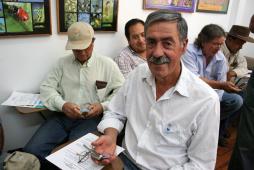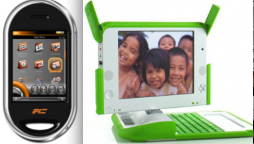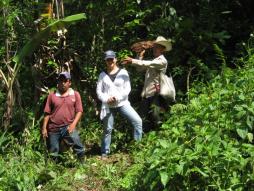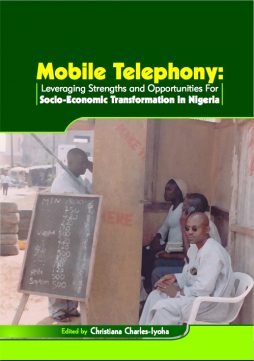Rural Issues
Posted by LeighJaschke on Aug 05, 2009
Mobile Phones and Financial Services in Developing Countries: A Review of Concepts, Methods, Issues, Evidence and Future R... data sheet 1187 Views
Author:
Duncombe Richard; Boateng Richard
Abstract:
Research concerning mobile phones and financial services in developing countries has undergone rapid growth in recent years. This paper seeks to improve understanding of this expanding research area and in so doing consider the potential for mobile phone applications for the delivery of financial services for the poor. The current state of knowledge is assessed by reviewing the content of 43 research articles drawn from both peer-reviewed academic journals and non-peer reviewed studies and other practitioner-orientated sources. A framework is developed that categorises and analyses the research according to a socio-technical spectrum, identifying levels of analysis and differentiating research activity according to a lifecycle model that incorporates financial needs, design and applications, adoption and adaptation, and impact. Positive aspects of research to-date are identified, most noticeably the high level of practitioner involvement in research publication and the strong links that have been forged between the mobile phone industry and the research community. This, however, has also caused research to become too narrowly defined and largely a- theoretical. Hence, research weaknesses and gaps are also identified suggesting that issues relating to financial needs and the measurement of impacts have been comparatively neglected, whilst application design and adoption have received greater attention. Emphasis tends to be on devices and new ways to deliver services, but ignores the broader context of financial services for the poor and tends to be technology-led. In order to correct this imbalance in research, the paper identifies key research gaps relating to concepts, methodologies, issues addressed and evidence presented and provides pointers to future research directions.
Posted by jalonso on Jul 29, 2009
Empleo efectivo de mensajes de texto (SMS) para mejorar la comercialización de productos agrícolas de pequeños productores data sheet 1346 Views
Abstract:
La telefonía móvil reduce la “distancia” entre los pequeños productores y las organizaciones locales, facilitando y haciendo más efectivo el intercambio de información y conocimientos. A través del uso del teléfono móvil, las redes sociales se fortalecen, los productores se empoderan y el costo de acceso a la información se reduce. Son inmensas las posibilidades que ofrecen los mensajes de texto SMS (hasta 160 caracteres) para compartir información a bajo costo y en forma instantánea. Con base en la información reunida durante mi participación en dos foros de la FAO sobre telefonía móvil y la revisión de algunas experiencias desarrolladas en África, Asia y América, sugiero una estrategia mediante la cual los pequeños productores podrían mejorar la comercialización de sus productos agrícolas al hacer un empleo efectivo de los mensajes de texto (SMS).
Posted by LeighJaschke on Jul 20, 2009
Mobile Learning in Developing Countries data sheet 2619 Views
Author:
Traxler, John; Kukulska-Hulme, Agnes
Abstract:
Mobile learning, or m-learning, is a personal, unobtrusive, spontaneous,
“anytime, anywhere” way to learn and to access educational tools and
material that enlarges access to education for all. It reinforces learners’
sense of ownership of the learning experience, offering them flexibility in
how, when and where they learn.
In developing countries, mobile technologies potentially deliver educa-
tion without dependence on an extensive traditional communications infra-
structure, leapfrogging some of the intervening development phases encoun-
tered in developed countries such as installing extensive electricity power
grids, and building multiple computer rooms in educational institutions.
Although m-learning experience remains limited, it is becoming a
credible, cost-effective component of blended open and distance learning
(ODL) provisions, adaptable to an institution’s needs and situation.
M-learning devices are lightweight and handheld, including:
• Personal Digital Assistants (PDAs), and palmtop or handheld
computers.
• Mobile phones, also called cell phones or handphones.
Consider mobile phones, which are cheap and widely available,
alongside other wireless communication devices; and handhelds, which
are more expensive and scarce, alongside desktop and laptop comput-
ers. Mobile devices are educationally interesting because they offer:
• Several communications channels on one device, for example,
email, voice, and text messaging.
• Cheaper, comparable functionality with desktops or laptops.
• Wireless access to educational materials, other students and
Internet resources.
Handhelds are currently the dominant mobile devices, apart from
basic mobile phones. These technologies are converging, creating power-
ful all-in-one tools such as “smartphones,” mobile phones with the func-
tionality of a handheld; and handhelds with mobile phone capability.
This guide focuses on the use of handheld computers or smartphones
in m-learning.
Posted by LeighJaschke on Jul 16, 2009
Wireless Technology for Social Change: Trends in Mobile Use by NGOs data sheet 3222 Views
Author:
Kinkade, Sheila; Verclas, Katrin
Publication Type:
Magazine or newspaper article
Abstract:
This report explores the ways in which non-
governmental organizations (NGOs) and
other groups deploy and use mobile
technology in their work to help solve some
of the world’s greatest problems. This study
is not meant to be exhaustive or definitive,
but rather to provide a view into how a
number of organizations are using mobile
technology to achieve social impact. The authors
selected case studies that enabled an
exploration of significant innovations,
opportunities, and emerging trends, as well
as the obstacles, in the use of mobile
technology to advance social goals.
Posted by LeighJaschke on Jul 14, 2009
ICT4D 2.0: The Next Phase of Applying ICT for International Development data sheet 1687 Views
Publication Type:
Magazine or newspaper article
Abstract:
Use of information and communication technologies for international development is moving
to its next phase. This will require new technologies, new approaches to innovation, new
intellectual integration, and, above all, a new view of the world’s poor. The phase change from information and communication
technologies for international
development (ICT4D) 1.0 to ICT4D 2.0 presents
opportunities for informatics professionals
and offers new markets for ICT vendors.
It also brings new challenges to our established methods
of working and emphasizes the need for new expertise
and new worldviews. Harnessing digital technologies in
the service of some of our world’s most severe problems
requires understanding these changes. Before proceeding,
though, we must ask why we should give priority to
ICT application for the poor in developing countries.
Posted by LeighJaschke on Jul 14, 2009
id21 insights 69 l September 2007: Research findings for development policymakers and practitioners id21 insights data sheet 2525 Views
Publication Type:
Magazine or newspaper article
Abstract:
id21 insights is published 10 times a year and is online at www.id21.org/insights. Readers
may copy or quote from any article, providing the source (id21 insights) and author are
acknowledged
and informed. To subscribe, email insights@ids.ac.uk with your name and
address. id21’s website, www.id21.org, offers free access to over 4,000 research highlights
on development policy issues including health, natural resources, education and more. This issue focuses on micro-entrepreneurs in Nigeria, mobile ladies in Bangladesh, unequal gender relations in Zambia, getting beyond the three billion mark, mobile banking and poor households in Jamaica.
Posted by LeighJaschke on Jul 14, 2009
The GSMA Development Fund Top 20 Research on the Economic and Social Impact of Mobile Communications in Developing Countries data sheet 3581 Views
Abstract:
The positive implications of landline telecoms infrastructure and, more recently, of mobile communications on
economic growth in the developed world have long been acknowledged, with numerous studies analysing the
issue. Now that most of the developed world has reached high penetration levels of mobile phones, both current
growth patterns and future projections suggest that virtually all of the mobile industry’s new customers in the
coming years will come from developing countries. In fact, as of 2007, there were more mobile customers in
developing countries than in the entire developed world (ITU).
What impact are mobile phones having on developing countries and are user experiences and overall impacts
unique or similar to those of developed countries? While it might seem intuitive to just extrapolate from the results
of earlier studies in developed countries, the developing world is in fact leap-frogging the developed world when
it comes to mobile communication and its many uses. The implications of this technology on daily life in
developing countries appear to be more far-reaching than they were in the earlier developed country rollouts. For
example, studies have demonstrated that mobile technology is driving improvements in social links, the creation
of social capital, improved market information flows and productivity, as well as increases in GDP and Foreign
Direct Investment.
This report surveys recent research and highlights the top studies in this area based on content, relevance,
originality and credibility. While it is not an exhaustive and scientifically developed list, it illustrates the work that
we feel is most important at the moment and highlights key conclusions on the impact of mobile technology in
developing countries.
Further, while the existing research is valuable in understanding the impacts, the literature is still limited in its
coverage and scope. We therefore recommend additional research to expand evidence and knowledge, particularly
with respect to basic economic studies, prospective applications and the needs of users around financial services.
We also call on stakeholders such as mobile operators, governments, industry groups, foundations and
development organisations to play their part in improving information sharing, increasing research and driving
developments in these countries.
Finally, we provide information on additional research on impacts and policy issues, as well.
Posted by LeighJaschke on Jul 07, 2009
The Role of Mobile Phones in Sustainable Rural Poverty Reduction data sheet 2092 Views
Author:
Bhavnani, Asheeta; Won-Wai Chiu, Rowena, Janakiram, Subramaniam; Silarszky, Peter
Abstract:
Many developing country governments and developing agencies are focusing on extending telecommunications services into rural areas, as they seek to alleviate poverty, encourage economic and social growth, and overcome a perceived ‘digital divide’. However, relatively little is known about how rural communities benefit from modern telecommunications services and what impact it is having on their lives and livelihoods. This paper endeavors to redress the balance, by examining the role of mobile telephones in sustainable poverty reduction among the rural poor.
Posted by LeighJaschke on Jul 07, 2009
e-IMCI: Improving Pediatric Health Care in Low-Income Countries data sheet 2198 Views
Author:
DeRenzi, Brian; Lesh, Neal; Parikh, Tapan; Sims, Clayton; Mitchell, Marc; Maokola, Werner; Chemba, Mwajuma; Hamisi, Yuna; Schellenberg, David; Borriello, Gaetano
Abstract:
Every year almost 10 million children die before reaching
the age of five despite the fact that two-thirds of these
deaths could be prevented by effective low-cost
interventions. To combat this, the World Health
Organization (WHO) and UNICEF developed the
Integrated Management of Childhood Illness (IMCI)
treatment algorithms.
In Tanzania, IMCI is the national policy for the treatment
of childhood illness. This paper describes e-IMCI, a system
for administering the IMCI protocol using a PDA. Our
preliminary investigation in rural Tanzania suggests that e-
IMCI is almost as fast as the common practice and
potentially improves care by increasing adherence to the
IMCI protocols. Additionally, we found clinicians could
quickly be trained to use e-IMCI and were very enthusiastic
about using it in the future.
Posted by LeighJaschke on Jul 01, 2009
Mobile phones use and social network development among small Malaysian retailers data sheet 1865 Views
Author:
Julsrud, Tom E.; Wong, Andrew; Roldan, Grace; Rohnes, Mette
Abstract:
In much literature on social capital, it has been a widely held assertion that networks of informal relations is beneficial for the development of local regions as well as larger nations (Fukuyama 1995; Putnam 2000; Woolcock 2001). Regional areas with a well developed network of informal connections and communities are believed to produce benefits leading to increased regional competitiveness, economic growth and prosperity. The last decade mobile communication tools have rapidly saturated several emerging markets in Asia and Africa (Donner 2008; Kumar and Thomas 2006). As a tool that is mainly used to connect individuals across space and time; mobile phones appears to have qualities that can spur social capital development for private persons as well as enterprises and larger regions. In line with this, some recent studies have found support the argument that mobile phones is beneficial for regional and local development (Goodman 2007; Jensen 2007). Still, others has been more reluctant and critical towards the “network effect” coming out of mobile phone usage among small enterprises (Chowdhury 2006) and some studies has found that private ties, rather than business relations are strengthened through the implementation of mobile phones (Donner 2004).
This paper addresses the question of mobile telephony usage and local development by looking at how mobile voice dialogues and SMS (text messages on mobile phones) are used by small enterprises in Malaysia. More explicitly, the study explores the kind of relations that are supported by these tools during the work day, as well as their physical proximity and perceived importance for business development. The study is based on in-depth studies of 12 small enterprises (between 5 and 20 employees) operating within agriculture, retail and financial services in the Selangor district. The paper presents initial findings, indicating differences in mobile phone usage between the three sectors, and highlighting general trends cutting across all sectors. Methodologically the study draws on quantitative social network techniques (to map mobile calls and SMS messages during a week), as well as qualitative interviews with managers and a sample of employees in the enterprises.
Posted by LeighJaschke on Jul 01, 2009
The Strategic use of mobile phone among poor people in some Latin American Countries data sheet 2339 Views
Abstract:
Mobile technology lets the users implement several strategies in order to minimize their spending. This paper documents the study of the determinants of the use of different strategies for a sample of users surveyed during May 2007 in developing countries as Argentina, Brazil, Colombia, Mexico, and Peru. This survey is focused in low income people and includes about 5500 people. The methodology used includes two steps. First, the study of the determinants of use of each strategy by means of a probabilistic model. It was found that educative level and age are important determinants of the use of the alternatives. Second, the use of a Poisson regression model to capture the intensity of use of these set of strategies. The findings differ among countries.
Posted by LeighJaschke on Jul 01, 2009
The Aceh Besar Midwives with Mobile Phones Program: Design and Evaluation Perspectives using the ICT for Healthcare Model data sheet 2549 Views
Abstract:
This paper examines the design process of the health communication process within the framework of the ICT-for-healthcare-development model (ICT4HC) (Author, Lwin, Ang, Lin, & Santoso, 2008). The paper analyzes the planned deployment of an ICT4H project that introduced a mobile telephony-based system to a specific group of users, rural midwives, and examine the myriad impacts and constraints that arise. The broad research question the paper aims to answer pertains to the design and evaluation of mobile phone-based ICT4H projects using a generalizable theoretical frameworks, specifically the ICT4HC model.
Posted by LeighJaschke on Jul 01, 2009
Education, mobile phone use and production decisions: a rural case study in Peru data sheet 1751 Views
Abstract:
In many parts of the world, mobile phones are important devices that have proven to be the first
opportunity for many people to have access to telecommunications. Considering the possible
impact of this development in welfare, the main purpose of this research is to investigate how
important formal education is for using mobile phones in making production decisions.
Specifically, we will analyze if this kind of technology is employed for production decisions in
rural areas in Puno, a Peruvian department in the southern highlands, bordering Bolivia. In
our case, production comprises livestock and agriculture. One of the main results is that no
matter how educated people are; if education is of poor quality, it will not have a significant
impact on the probability of making an effective use of mobile phones.
Posted by LeighJaschke on Jun 26, 2009
ATMosphere: A System for ATM Microdeposit Services in Rural Contexts data sheet 1328 Views
Author:
Paik, Michael; Subramanian, Lakshminarayanan
Abstract:
This paper describes strategies to lower the cost
of providing Automated Teller Machine microdeposit services
in rural contexts. Microdeposits represent a growing market
in the developing world, but the cost of running a
conventional ATM network is prohibitive due to the capital
investment required to deploy networks and terminals.
Our novel contributions are to use the Short Message
Service (SMS) over high-penetration GSM cellular networks
in conjunction with a system using location awareness to
intelligently distribute available balances among machines.
This allows us to provide high levels of service while
simultaneously reducing risk to the financial institution and
lowering per-transaction cost.
Using a simulation of ATM usage patterns and
distributions, our primary results under our model are: (1)
transaction cost per user per year can be optimized to less
than USD 0.18 given an SMS loss rate of approximately 10%
while (2) customer withdrawal success rate can be maintained
at approximately 98% with (3) a maximum of 5% of funds on
deposit available in cash in ATMs at any given time.
These results make wide deployment of rural ATM services
by financial institutions feasible and economically viable in
the near term using existing commodity tech
Posted by CorinneRamey on Jun 16, 2009
At a small agrarian cooperative in Chile, farmers with little access to the internet have a new source of farming information: text messaging. The messages, a combination of national and international news and farming information about topics like weather and pricing, are part of a project called DatAgro, which aims to bring relevant farming information to rural populations that have little access to computers.
DatAgro is a collaboration between Washington, D.C.-based nonprofit DataDyne and the Santiago-based Zoltner Consulting Group, which looks at ways that ICTs can be used for development. The project is primarily funded by a $325,000 Knight News Challenge Grant and will continue until November 2010.
Posted by LeighJaschke on Jun 16, 2009
Cellphones for Health: An Exploration of Interventions in South Africa data sheet 1641 Views
Abstract:
There is global use of technology in medicine and health communication, leading to terms such as telemedicine, telehealth and e-health. A wide range of information and communication technologies (ICTs) has been used both in the provision of services, as well as in messaging and communication campaigns. In South Africa limited internet penetration has led to more experimentation with cellphones. This paper provides a discussion of these projects, focusing on: The Teen SMS Helpline of the South African Depression and Anxiety Group; SIMPill which assists with compliance to tuberculosis medication; and CellLife’s Cellphones for HIV programme. The projects are described, with reflection on the possibilities for the uses of cellphones in healthcare, weighing advantages and disadvantages, particularly in the local context.
Posted by cmasiello on Apr 13, 2009
MobileActive members are invited to participate in the upcoming virtual forum on Mobile Telephony in Rural Areas (e-agriculture) 20-30 April 2009. The dicussions will be in Spanish.
Posted by KatrinVerclas on Jan 26, 2009
The ongoing debate over the value of cheap and open laptops for users in developing countries as opposed to mobile phones continues, most recently with a post from Cory Doctorow in the Guardian UK. The One Laptop Per Child (OLPC) initiative, the most visible and audacious of the low-cost laptop projects, has been in the news recently for cutting half its staff and severely scaling back and refocusing its operations. OLPC had originally promised to promote economic development by distributing free computers to two billion children in developing countries.
Doctorow in the Guardian argues what we all believe in -- that information technology is an essential ingredient to economic development. He notes:
Posted by sharakarasic on Nov 01, 2008
On day two of the MobileActive ’08 conference, I attended The Humanitarian Technology Challenge: In Search of Innovative Solutions presented by Claire Thwaites, who heads the technology partnership between Vodaphone and the UN Foundation.
Thwaites said that their goal is to find technology solutions to humanitarian challenges. The IEEE lists five key challenges which Thwaites presented:
Reliable Electricity
Needs: Power availability for electronic devices, including low power stationary facilities, rugged mobile power supplies for emergency settings, mechanical transducers, passive generation devices that charge as you walk. Renewable energy hubs are preferred, as well as the use of intermediate field offices as data relay points.
Data Connectivity of Rural Health District Offices
Needs: Exchange data between central health facilities and remote field offices. Two-way transmission – upload/download, data could be batched for daily transfer, also useful for emergency alerts and outbreak alerts, less expensive service and higher bandwidth needed, maps of existing connectivity
Posted by sharakarasic on Oct 14, 2008
I spoke with Ian Puttergill of Microsoft Digital Divide Solutions. They are working on taking the power of web and data capabilities and extending that to mobiles. He demonstrated an SMS hookup to Excel based on SMS Toolkit that can be used for data collection and analysis in rural areas. In Kampala, Uganda they consulted with midwives to design a system that would find out what equipment, training, and medication local populations needed. They are currently still working on that system and its feasability - it's not yet in the field.
Posted by sharakarasic on Oct 14, 2008
Yesterday I attended the session "OpenRosa mHealth in Tanzania" presented by Gayo Mhila and Neal Lesh. Gayo told us about CommCare, an OpenRosa mobile data collection application which enables community health workers (CHWs) to easily collect patient data through their mobiles. OpenRosa is a consortium for mobile data collection and decision support.
Community health workers serve poor, rural populations, promote preventative care, convey health information, and collect data. Their challenge in being able to use applications such as CommCare include limited network coverage, the fact that it's hard to charge phones in rural areas (solar charger, anyone?), airtime management of personal calls in the case of granted airtime, and understanding of technology.
I asked Gayo about how the CHW's found patients to survey, especially since privacy is such an issue for the population with HIV and TB. He said that health workers direct patients to go to the NGO to get help, so it is their initiative to work with them.
Another audience member mentioned how complicated navigation on donated cellphones was an issue in her project.
Posted by KatrinVerclas on Sep 09, 2008
Yael Schwartzmann is a social entrepreneur, a programmer, and a mobile innovator. She developed a mobile data collection application-- DigitalICS -- to monitor smallholder coffee farmers' compliance with organic, fair trade certifications and quality requirements at a rural coffee cooperative in Oaxaca, Mexico. Yael will feature DigitalICS (pronounced Digitalix) at MobileActive08's SIMPlace. In my interview with her, we discuss why mobile phones are so useful for agricultural data collection on compliance and certification, how the application works, where else it could be used, and why she is passionate about her work.
Here is the audio of my interview with Yael; an edited transcript follows.
Posted by KatrinVerclas on Aug 09, 2008
In our series of interviews from the Bellagio conference on mobile health, here is David Sasaki's last interview with Patricia Mechael who is coordinating the mobile strategy for the Millennium Village Project. She talks about mobile adoption, user-centric design, women and mobiles, how Millennium Villages is using mobiles to improve health outcomes, and what she sees as the next big projects in mobile health.
David Oso: You have worked in a number of countries -- Egypt, Sudan, the UK, Bangladesh, Cambodia, Mozambique, Russia, Rwanda, the list keeps going on and on. How are cell phones used differently in these different countries where you've worked?
Posted by dsasaki on Jul 30, 2008
Mobile banking has been touted as such a wild success story for one simple reason: mobile phones have penetrated the market in rural areas of developing countries in the last five years more successfully than traditional banks have been able to over the past 100 years. You can travel to any remote village just about anywhere in Sub-Saharan Africa and it is rare that you will find a bank; far rarer that you will find an ATM. (I remember waiting three and a half hours to use an ATM once in Namibia.) But you are guaranteed to hear ringtones.
Once banks realized that basic financial transactions (deposit, withdrawal, payment, check balance) can all be done over a mobile phone, they understood that the banking services they offer can finally reach customers in places where just a few years earlier they had never dreamed of doing business.
Posted by CorinneRamey on Feb 29, 2008
The brightly-colored umbrellas of mobile phone vendors, selling top-up airtime and the use of mobile phones for calls, dot the landscape of urban and rural Nigeria. However, says a new book on mobile phones in Nigeria, cell phones haven't just visually changed the landscape of Africa's most populous country, but have transformed the country economically, socially, and democratically as well.







